BSBWHS401: WHS Policies Implementation - Detailed Activity Solutions
VerifiedAdded on 2023/06/18
|16
|4860
|152
Homework Assignment
AI Summary
This document provides solutions to various activities related to BSBWHS401, which focuses on implementing and monitoring Workplace Health and Safety (WHS) policies and procedures. The solutions cover key areas such as providing WHS information to work teams, implementing participation arrangements for managing WHS, identifying WHS training needs, providing workplace learning opportunities, and managing workplace hazards. Specific topics addressed include explaining WHS legislation, communicating organizational WHS policies, identifying workplace hazards, consulting with personnel to manage health and safety risks, meeting WHS regulatory requirements, and recording WHS consultation outcomes. Additionally, the document details examples of common workplace hazards, actions to take when a hazard is reported, the hierarchy of control for managing risks, and the details needed for completing a WHS record following an incident. The document also outlines the costs associated with providing WHS training for the work team.
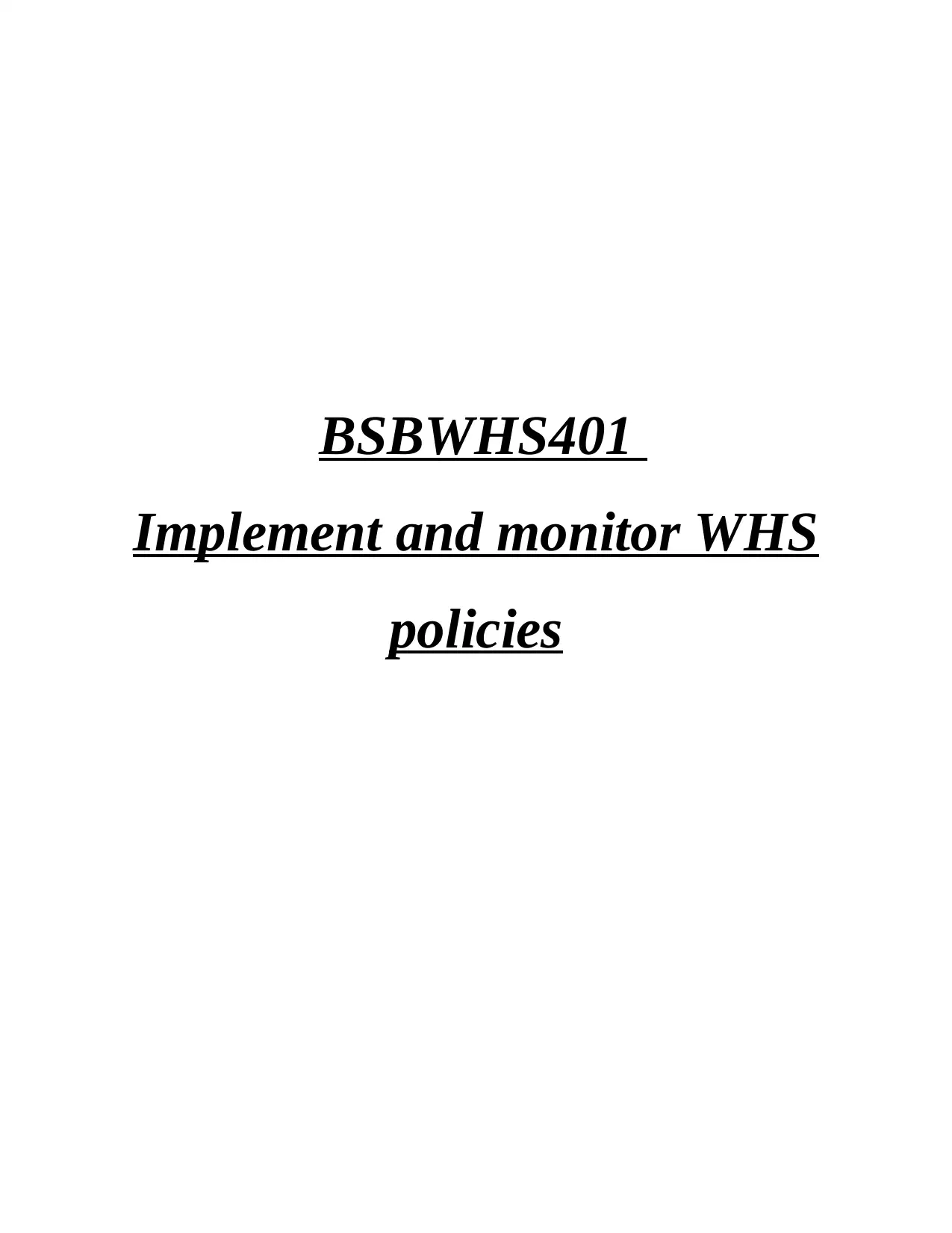
BSBWHS401
Implement and monitor WHS
policies
Implement and monitor WHS
policies
Paraphrase This Document
Need a fresh take? Get an instant paraphrase of this document with our AI Paraphraser
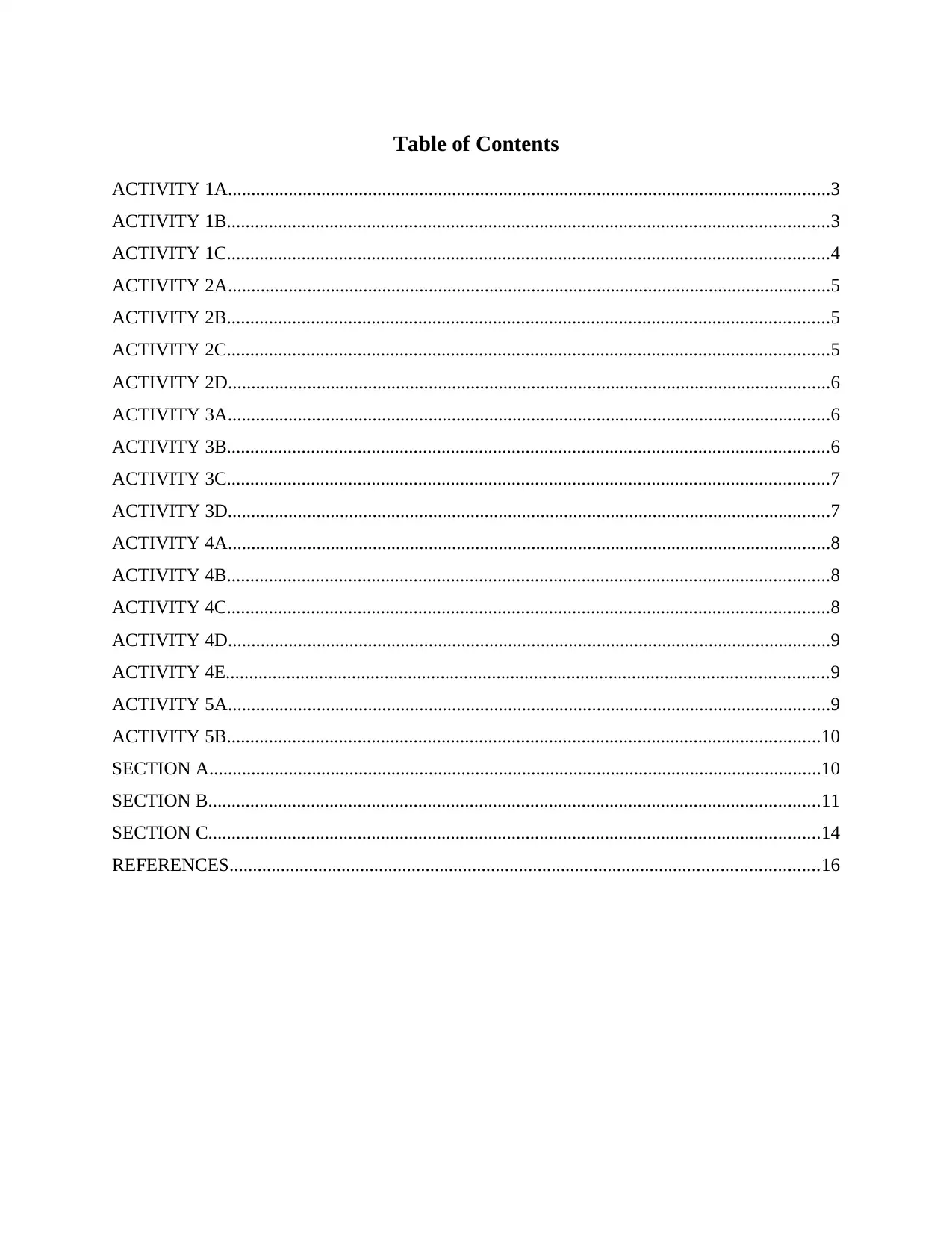
Table of Contents
ACTIVITY 1A.................................................................................................................................3
ACTIVITY 1B.................................................................................................................................3
ACTIVITY 1C.................................................................................................................................4
ACTIVITY 2A.................................................................................................................................5
ACTIVITY 2B.................................................................................................................................5
ACTIVITY 2C.................................................................................................................................5
ACTIVITY 2D.................................................................................................................................6
ACTIVITY 3A.................................................................................................................................6
ACTIVITY 3B.................................................................................................................................6
ACTIVITY 3C.................................................................................................................................7
ACTIVITY 3D.................................................................................................................................7
ACTIVITY 4A.................................................................................................................................8
ACTIVITY 4B.................................................................................................................................8
ACTIVITY 4C.................................................................................................................................8
ACTIVITY 4D.................................................................................................................................9
ACTIVITY 4E.................................................................................................................................9
ACTIVITY 5A.................................................................................................................................9
ACTIVITY 5B...............................................................................................................................10
SECTION A...................................................................................................................................10
SECTION B...................................................................................................................................11
SECTION C...................................................................................................................................14
REFERENCES..............................................................................................................................16
ACTIVITY 1A.................................................................................................................................3
ACTIVITY 1B.................................................................................................................................3
ACTIVITY 1C.................................................................................................................................4
ACTIVITY 2A.................................................................................................................................5
ACTIVITY 2B.................................................................................................................................5
ACTIVITY 2C.................................................................................................................................5
ACTIVITY 2D.................................................................................................................................6
ACTIVITY 3A.................................................................................................................................6
ACTIVITY 3B.................................................................................................................................6
ACTIVITY 3C.................................................................................................................................7
ACTIVITY 3D.................................................................................................................................7
ACTIVITY 4A.................................................................................................................................8
ACTIVITY 4B.................................................................................................................................8
ACTIVITY 4C.................................................................................................................................8
ACTIVITY 4D.................................................................................................................................9
ACTIVITY 4E.................................................................................................................................9
ACTIVITY 5A.................................................................................................................................9
ACTIVITY 5B...............................................................................................................................10
SECTION A...................................................................................................................................10
SECTION B...................................................................................................................................11
SECTION C...................................................................................................................................14
REFERENCES..............................................................................................................................16
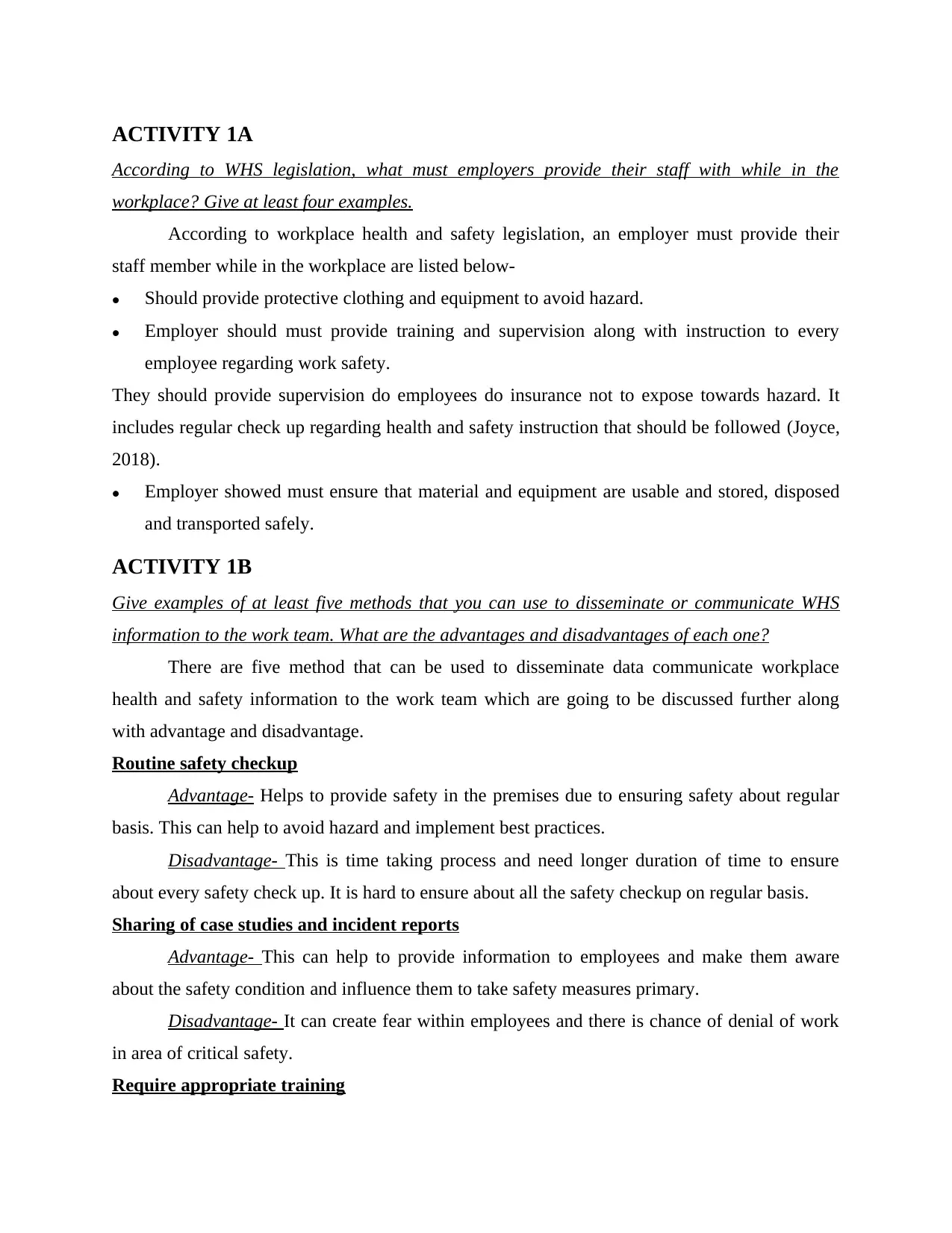
ACTIVITY 1A
According to WHS legislation, what must employers provide their staff with while in the
workplace? Give at least four examples.
According to workplace health and safety legislation, an employer must provide their
staff member while in the workplace are listed below-
Should provide protective clothing and equipment to avoid hazard.
Employer should must provide training and supervision along with instruction to every
employee regarding work safety.
They should provide supervision do employees do insurance not to expose towards hazard. It
includes regular check up regarding health and safety instruction that should be followed (Joyce,
2018).
Employer showed must ensure that material and equipment are usable and stored, disposed
and transported safely.
ACTIVITY 1B
Give examples of at least five methods that you can use to disseminate or communicate WHS
information to the work team. What are the advantages and disadvantages of each one?
There are five method that can be used to disseminate data communicate workplace
health and safety information to the work team which are going to be discussed further along
with advantage and disadvantage.
Routine safety checkup
Advantage- Helps to provide safety in the premises due to ensuring safety about regular
basis. This can help to avoid hazard and implement best practices.
Disadvantage- This is time taking process and need longer duration of time to ensure
about every safety check up. It is hard to ensure about all the safety checkup on regular basis.
Sharing of case studies and incident reports
Advantage- This can help to provide information to employees and make them aware
about the safety condition and influence them to take safety measures primary.
Disadvantage- It can create fear within employees and there is chance of denial of work
in area of critical safety.
Require appropriate training
According to WHS legislation, what must employers provide their staff with while in the
workplace? Give at least four examples.
According to workplace health and safety legislation, an employer must provide their
staff member while in the workplace are listed below-
Should provide protective clothing and equipment to avoid hazard.
Employer should must provide training and supervision along with instruction to every
employee regarding work safety.
They should provide supervision do employees do insurance not to expose towards hazard. It
includes regular check up regarding health and safety instruction that should be followed (Joyce,
2018).
Employer showed must ensure that material and equipment are usable and stored, disposed
and transported safely.
ACTIVITY 1B
Give examples of at least five methods that you can use to disseminate or communicate WHS
information to the work team. What are the advantages and disadvantages of each one?
There are five method that can be used to disseminate data communicate workplace
health and safety information to the work team which are going to be discussed further along
with advantage and disadvantage.
Routine safety checkup
Advantage- Helps to provide safety in the premises due to ensuring safety about regular
basis. This can help to avoid hazard and implement best practices.
Disadvantage- This is time taking process and need longer duration of time to ensure
about every safety check up. It is hard to ensure about all the safety checkup on regular basis.
Sharing of case studies and incident reports
Advantage- This can help to provide information to employees and make them aware
about the safety condition and influence them to take safety measures primary.
Disadvantage- It can create fear within employees and there is chance of denial of work
in area of critical safety.
Require appropriate training
⊘ This is a preview!⊘
Do you want full access?
Subscribe today to unlock all pages.

Trusted by 1+ million students worldwide
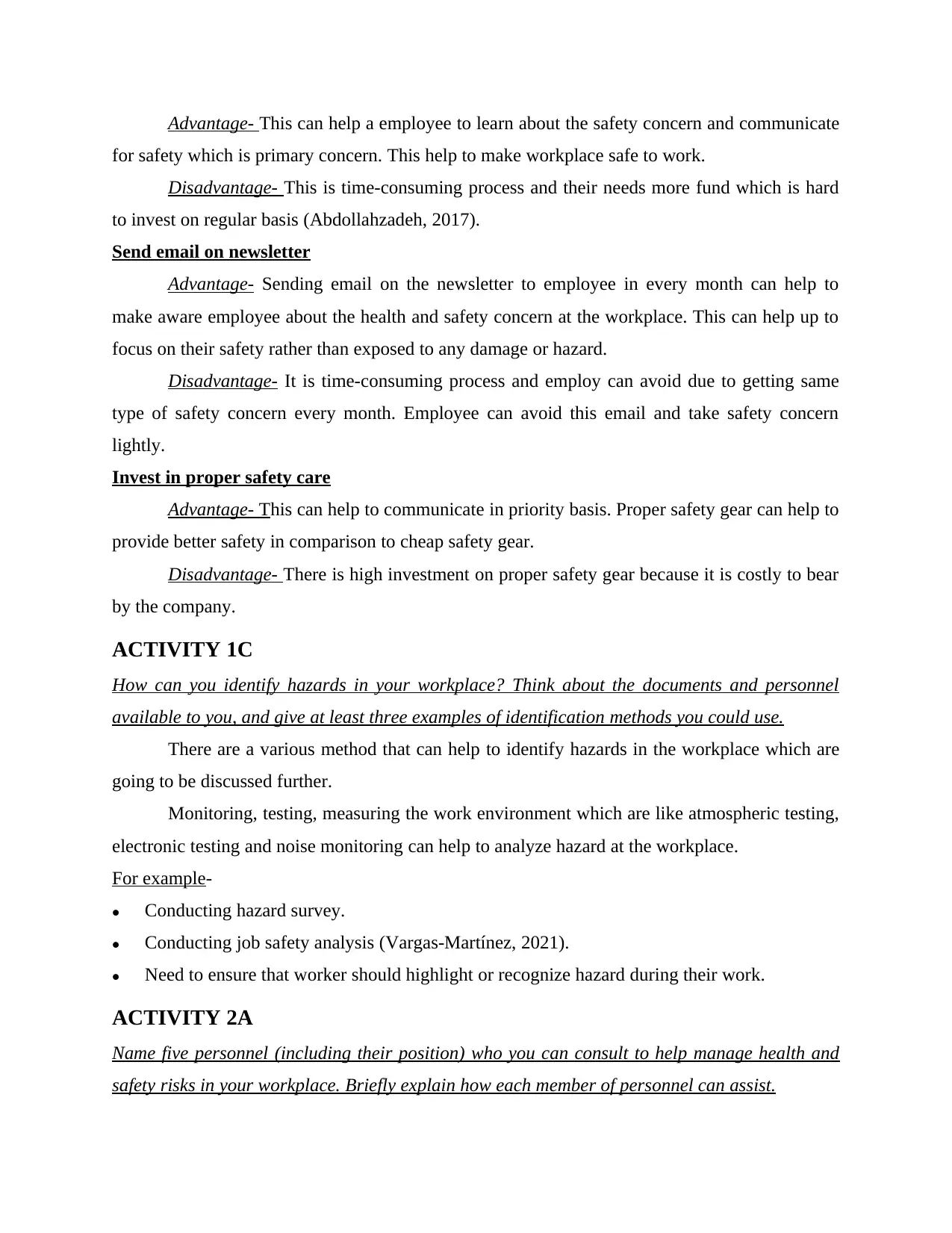
Advantage- This can help a employee to learn about the safety concern and communicate
for safety which is primary concern. This help to make workplace safe to work.
Disadvantage- This is time-consuming process and their needs more fund which is hard
to invest on regular basis (Abdollahzadeh, 2017).
Send email on newsletter
Advantage- Sending email on the newsletter to employee in every month can help to
make aware employee about the health and safety concern at the workplace. This can help up to
focus on their safety rather than exposed to any damage or hazard.
Disadvantage- It is time-consuming process and employ can avoid due to getting same
type of safety concern every month. Employee can avoid this email and take safety concern
lightly.
Invest in proper safety care
Advantage- This can help to communicate in priority basis. Proper safety gear can help to
provide better safety in comparison to cheap safety gear.
Disadvantage- There is high investment on proper safety gear because it is costly to bear
by the company.
ACTIVITY 1C
How can you identify hazards in your workplace? Think about the documents and personnel
available to you, and give at least three examples of identification methods you could use.
There are a various method that can help to identify hazards in the workplace which are
going to be discussed further.
Monitoring, testing, measuring the work environment which are like atmospheric testing,
electronic testing and noise monitoring can help to analyze hazard at the workplace.
For example-
Conducting hazard survey.
Conducting job safety analysis (Vargas‐Martínez, 2021).
Need to ensure that worker should highlight or recognize hazard during their work.
ACTIVITY 2A
Name five personnel (including their position) who you can consult to help manage health and
safety risks in your workplace. Briefly explain how each member of personnel can assist.
for safety which is primary concern. This help to make workplace safe to work.
Disadvantage- This is time-consuming process and their needs more fund which is hard
to invest on regular basis (Abdollahzadeh, 2017).
Send email on newsletter
Advantage- Sending email on the newsletter to employee in every month can help to
make aware employee about the health and safety concern at the workplace. This can help up to
focus on their safety rather than exposed to any damage or hazard.
Disadvantage- It is time-consuming process and employ can avoid due to getting same
type of safety concern every month. Employee can avoid this email and take safety concern
lightly.
Invest in proper safety care
Advantage- This can help to communicate in priority basis. Proper safety gear can help to
provide better safety in comparison to cheap safety gear.
Disadvantage- There is high investment on proper safety gear because it is costly to bear
by the company.
ACTIVITY 1C
How can you identify hazards in your workplace? Think about the documents and personnel
available to you, and give at least three examples of identification methods you could use.
There are a various method that can help to identify hazards in the workplace which are
going to be discussed further.
Monitoring, testing, measuring the work environment which are like atmospheric testing,
electronic testing and noise monitoring can help to analyze hazard at the workplace.
For example-
Conducting hazard survey.
Conducting job safety analysis (Vargas‐Martínez, 2021).
Need to ensure that worker should highlight or recognize hazard during their work.
ACTIVITY 2A
Name five personnel (including their position) who you can consult to help manage health and
safety risks in your workplace. Briefly explain how each member of personnel can assist.
Paraphrase This Document
Need a fresh take? Get an instant paraphrase of this document with our AI Paraphraser
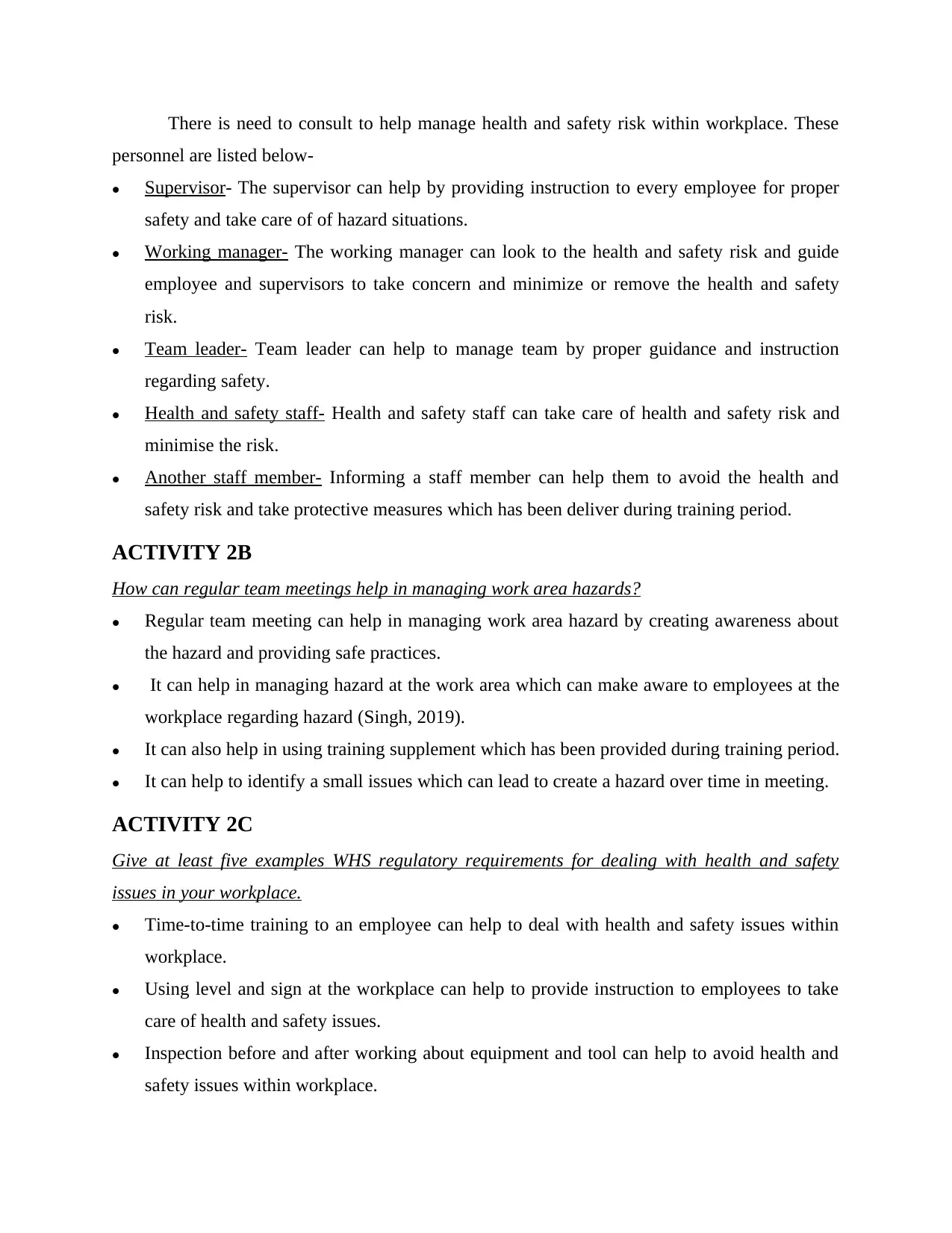
There is need to consult to help manage health and safety risk within workplace. These
personnel are listed below-
Supervisor- The supervisor can help by providing instruction to every employee for proper
safety and take care of of hazard situations.
Working manager- The working manager can look to the health and safety risk and guide
employee and supervisors to take concern and minimize or remove the health and safety
risk.
Team leader- Team leader can help to manage team by proper guidance and instruction
regarding safety.
Health and safety staff- Health and safety staff can take care of health and safety risk and
minimise the risk.
Another staff member- Informing a staff member can help them to avoid the health and
safety risk and take protective measures which has been deliver during training period.
ACTIVITY 2B
How can regular team meetings help in managing work area hazards?
Regular team meeting can help in managing work area hazard by creating awareness about
the hazard and providing safe practices.
It can help in managing hazard at the work area which can make aware to employees at the
workplace regarding hazard (Singh, 2019).
It can also help in using training supplement which has been provided during training period.
It can help to identify a small issues which can lead to create a hazard over time in meeting.
ACTIVITY 2C
Give at least five examples WHS regulatory requirements for dealing with health and safety
issues in your workplace.
Time-to-time training to an employee can help to deal with health and safety issues within
workplace.
Using level and sign at the workplace can help to provide instruction to employees to take
care of health and safety issues.
Inspection before and after working about equipment and tool can help to avoid health and
safety issues within workplace.
personnel are listed below-
Supervisor- The supervisor can help by providing instruction to every employee for proper
safety and take care of of hazard situations.
Working manager- The working manager can look to the health and safety risk and guide
employee and supervisors to take concern and minimize or remove the health and safety
risk.
Team leader- Team leader can help to manage team by proper guidance and instruction
regarding safety.
Health and safety staff- Health and safety staff can take care of health and safety risk and
minimise the risk.
Another staff member- Informing a staff member can help them to avoid the health and
safety risk and take protective measures which has been deliver during training period.
ACTIVITY 2B
How can regular team meetings help in managing work area hazards?
Regular team meeting can help in managing work area hazard by creating awareness about
the hazard and providing safe practices.
It can help in managing hazard at the work area which can make aware to employees at the
workplace regarding hazard (Singh, 2019).
It can also help in using training supplement which has been provided during training period.
It can help to identify a small issues which can lead to create a hazard over time in meeting.
ACTIVITY 2C
Give at least five examples WHS regulatory requirements for dealing with health and safety
issues in your workplace.
Time-to-time training to an employee can help to deal with health and safety issues within
workplace.
Using level and sign at the workplace can help to provide instruction to employees to take
care of health and safety issues.
Inspection before and after working about equipment and tool can help to avoid health and
safety issues within workplace.
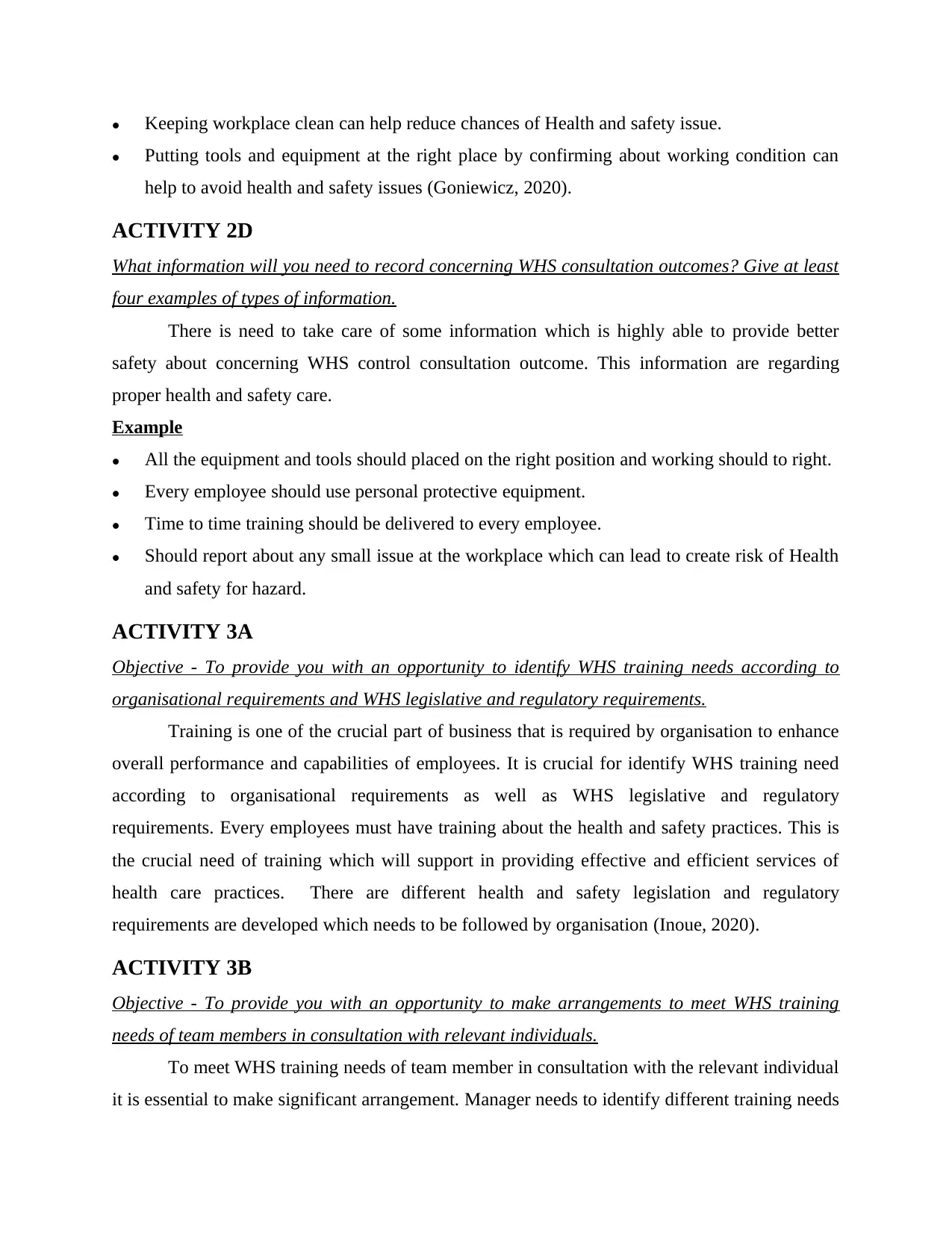
Keeping workplace clean can help reduce chances of Health and safety issue.
Putting tools and equipment at the right place by confirming about working condition can
help to avoid health and safety issues (Goniewicz, 2020).
ACTIVITY 2D
What information will you need to record concerning WHS consultation outcomes? Give at least
four examples of types of information.
There is need to take care of some information which is highly able to provide better
safety about concerning WHS control consultation outcome. This information are regarding
proper health and safety care.
Example
All the equipment and tools should placed on the right position and working should to right.
Every employee should use personal protective equipment.
Time to time training should be delivered to every employee.
Should report about any small issue at the workplace which can lead to create risk of Health
and safety for hazard.
ACTIVITY 3A
Objective - To provide you with an opportunity to identify WHS training needs according to
organisational requirements and WHS legislative and regulatory requirements.
Training is one of the crucial part of business that is required by organisation to enhance
overall performance and capabilities of employees. It is crucial for identify WHS training need
according to organisational requirements as well as WHS legislative and regulatory
requirements. Every employees must have training about the health and safety practices. This is
the crucial need of training which will support in providing effective and efficient services of
health care practices. There are different health and safety legislation and regulatory
requirements are developed which needs to be followed by organisation (Inoue, 2020).
ACTIVITY 3B
Objective - To provide you with an opportunity to make arrangements to meet WHS training
needs of team members in consultation with relevant individuals.
To meet WHS training needs of team member in consultation with the relevant individual
it is essential to make significant arrangement. Manager needs to identify different training needs
Putting tools and equipment at the right place by confirming about working condition can
help to avoid health and safety issues (Goniewicz, 2020).
ACTIVITY 2D
What information will you need to record concerning WHS consultation outcomes? Give at least
four examples of types of information.
There is need to take care of some information which is highly able to provide better
safety about concerning WHS control consultation outcome. This information are regarding
proper health and safety care.
Example
All the equipment and tools should placed on the right position and working should to right.
Every employee should use personal protective equipment.
Time to time training should be delivered to every employee.
Should report about any small issue at the workplace which can lead to create risk of Health
and safety for hazard.
ACTIVITY 3A
Objective - To provide you with an opportunity to identify WHS training needs according to
organisational requirements and WHS legislative and regulatory requirements.
Training is one of the crucial part of business that is required by organisation to enhance
overall performance and capabilities of employees. It is crucial for identify WHS training need
according to organisational requirements as well as WHS legislative and regulatory
requirements. Every employees must have training about the health and safety practices. This is
the crucial need of training which will support in providing effective and efficient services of
health care practices. There are different health and safety legislation and regulatory
requirements are developed which needs to be followed by organisation (Inoue, 2020).
ACTIVITY 3B
Objective - To provide you with an opportunity to make arrangements to meet WHS training
needs of team members in consultation with relevant individuals.
To meet WHS training needs of team member in consultation with the relevant individual
it is essential to make significant arrangement. Manager needs to identify different training needs
⊘ This is a preview!⊘
Do you want full access?
Subscribe today to unlock all pages.

Trusted by 1+ million students worldwide
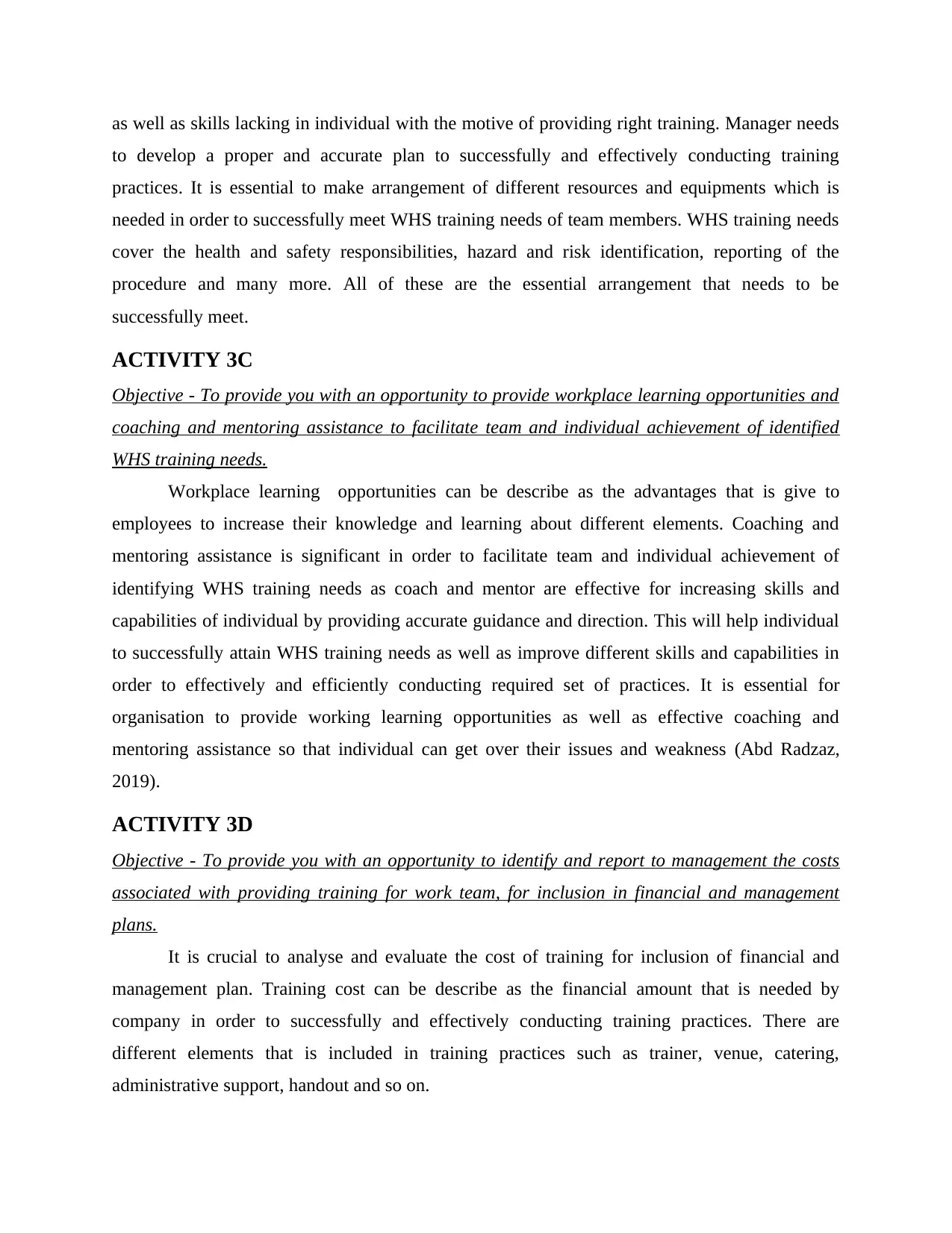
as well as skills lacking in individual with the motive of providing right training. Manager needs
to develop a proper and accurate plan to successfully and effectively conducting training
practices. It is essential to make arrangement of different resources and equipments which is
needed in order to successfully meet WHS training needs of team members. WHS training needs
cover the health and safety responsibilities, hazard and risk identification, reporting of the
procedure and many more. All of these are the essential arrangement that needs to be
successfully meet.
ACTIVITY 3C
Objective - To provide you with an opportunity to provide workplace learning opportunities and
coaching and mentoring assistance to facilitate team and individual achievement of identified
WHS training needs.
Workplace learning opportunities can be describe as the advantages that is give to
employees to increase their knowledge and learning about different elements. Coaching and
mentoring assistance is significant in order to facilitate team and individual achievement of
identifying WHS training needs as coach and mentor are effective for increasing skills and
capabilities of individual by providing accurate guidance and direction. This will help individual
to successfully attain WHS training needs as well as improve different skills and capabilities in
order to effectively and efficiently conducting required set of practices. It is essential for
organisation to provide working learning opportunities as well as effective coaching and
mentoring assistance so that individual can get over their issues and weakness (Abd Radzaz,
2019).
ACTIVITY 3D
Objective - To provide you with an opportunity to identify and report to management the costs
associated with providing training for work team, for inclusion in financial and management
plans.
It is crucial to analyse and evaluate the cost of training for inclusion of financial and
management plan. Training cost can be describe as the financial amount that is needed by
company in order to successfully and effectively conducting training practices. There are
different elements that is included in training practices such as trainer, venue, catering,
administrative support, handout and so on.
to develop a proper and accurate plan to successfully and effectively conducting training
practices. It is essential to make arrangement of different resources and equipments which is
needed in order to successfully meet WHS training needs of team members. WHS training needs
cover the health and safety responsibilities, hazard and risk identification, reporting of the
procedure and many more. All of these are the essential arrangement that needs to be
successfully meet.
ACTIVITY 3C
Objective - To provide you with an opportunity to provide workplace learning opportunities and
coaching and mentoring assistance to facilitate team and individual achievement of identified
WHS training needs.
Workplace learning opportunities can be describe as the advantages that is give to
employees to increase their knowledge and learning about different elements. Coaching and
mentoring assistance is significant in order to facilitate team and individual achievement of
identifying WHS training needs as coach and mentor are effective for increasing skills and
capabilities of individual by providing accurate guidance and direction. This will help individual
to successfully attain WHS training needs as well as improve different skills and capabilities in
order to effectively and efficiently conducting required set of practices. It is essential for
organisation to provide working learning opportunities as well as effective coaching and
mentoring assistance so that individual can get over their issues and weakness (Abd Radzaz,
2019).
ACTIVITY 3D
Objective - To provide you with an opportunity to identify and report to management the costs
associated with providing training for work team, for inclusion in financial and management
plans.
It is crucial to analyse and evaluate the cost of training for inclusion of financial and
management plan. Training cost can be describe as the financial amount that is needed by
company in order to successfully and effectively conducting training practices. There are
different elements that is included in training practices such as trainer, venue, catering,
administrative support, handout and so on.
Paraphrase This Document
Need a fresh take? Get an instant paraphrase of this document with our AI Paraphraser
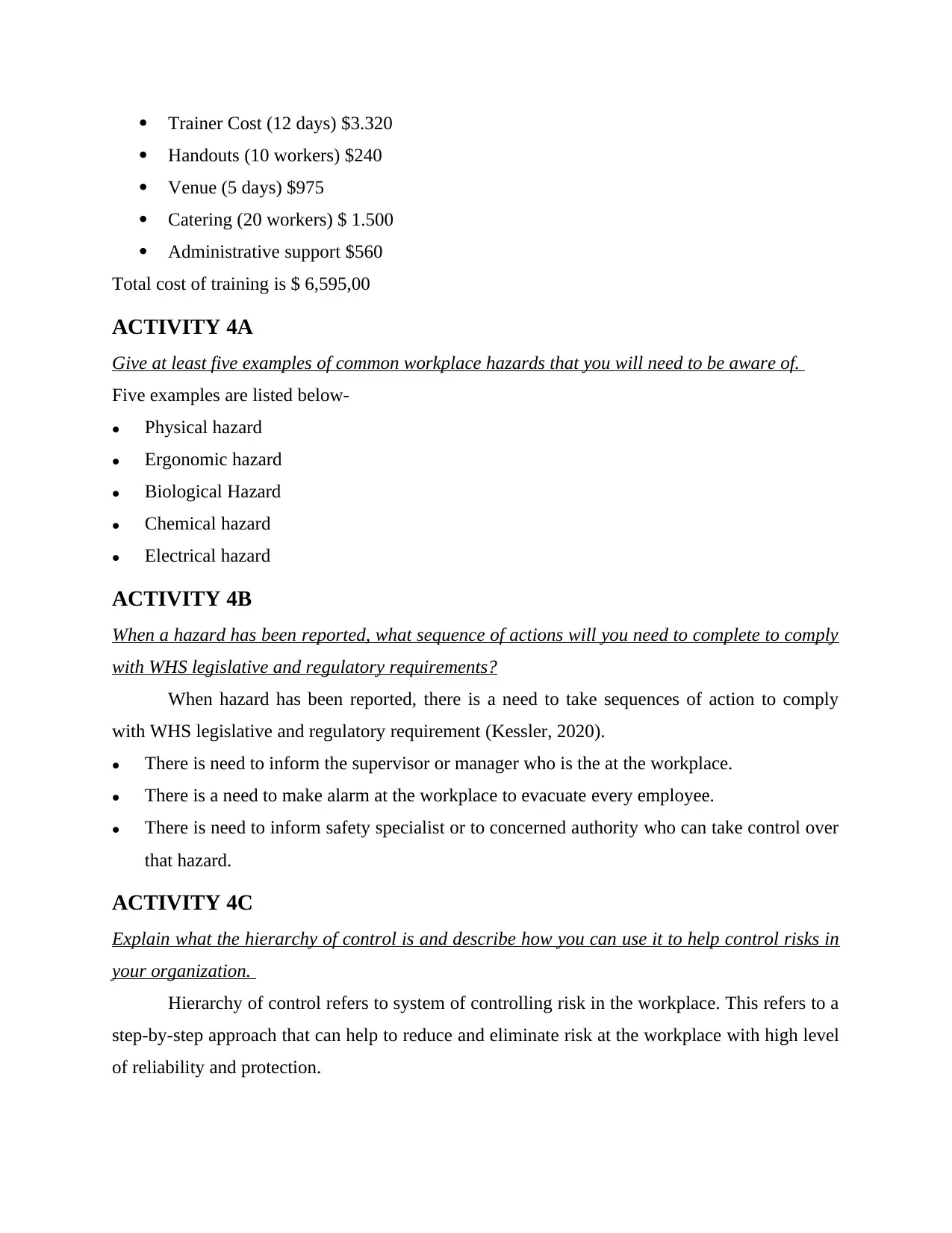
Trainer Cost (12 days) $3.320
Handouts (10 workers) $240
Venue (5 days) $975
Catering (20 workers) $ 1.500
Administrative support $560
Total cost of training is $ 6,595,00
ACTIVITY 4A
Give at least five examples of common workplace hazards that you will need to be aware of.
Five examples are listed below-
Physical hazard
Ergonomic hazard
Biological Hazard
Chemical hazard
Electrical hazard
ACTIVITY 4B
When a hazard has been reported, what sequence of actions will you need to complete to comply
with WHS legislative and regulatory requirements?
When hazard has been reported, there is a need to take sequences of action to comply
with WHS legislative and regulatory requirement (Kessler, 2020).
There is need to inform the supervisor or manager who is the at the workplace.
There is a need to make alarm at the workplace to evacuate every employee.
There is need to inform safety specialist or to concerned authority who can take control over
that hazard.
ACTIVITY 4C
Explain what the hierarchy of control is and describe how you can use it to help control risks in
your organization.
Hierarchy of control refers to system of controlling risk in the workplace. This refers to a
step-by-step approach that can help to reduce and eliminate risk at the workplace with high level
of reliability and protection.
Handouts (10 workers) $240
Venue (5 days) $975
Catering (20 workers) $ 1.500
Administrative support $560
Total cost of training is $ 6,595,00
ACTIVITY 4A
Give at least five examples of common workplace hazards that you will need to be aware of.
Five examples are listed below-
Physical hazard
Ergonomic hazard
Biological Hazard
Chemical hazard
Electrical hazard
ACTIVITY 4B
When a hazard has been reported, what sequence of actions will you need to complete to comply
with WHS legislative and regulatory requirements?
When hazard has been reported, there is a need to take sequences of action to comply
with WHS legislative and regulatory requirement (Kessler, 2020).
There is need to inform the supervisor or manager who is the at the workplace.
There is a need to make alarm at the workplace to evacuate every employee.
There is need to inform safety specialist or to concerned authority who can take control over
that hazard.
ACTIVITY 4C
Explain what the hierarchy of control is and describe how you can use it to help control risks in
your organization.
Hierarchy of control refers to system of controlling risk in the workplace. This refers to a
step-by-step approach that can help to reduce and eliminate risk at the workplace with high level
of reliability and protection.
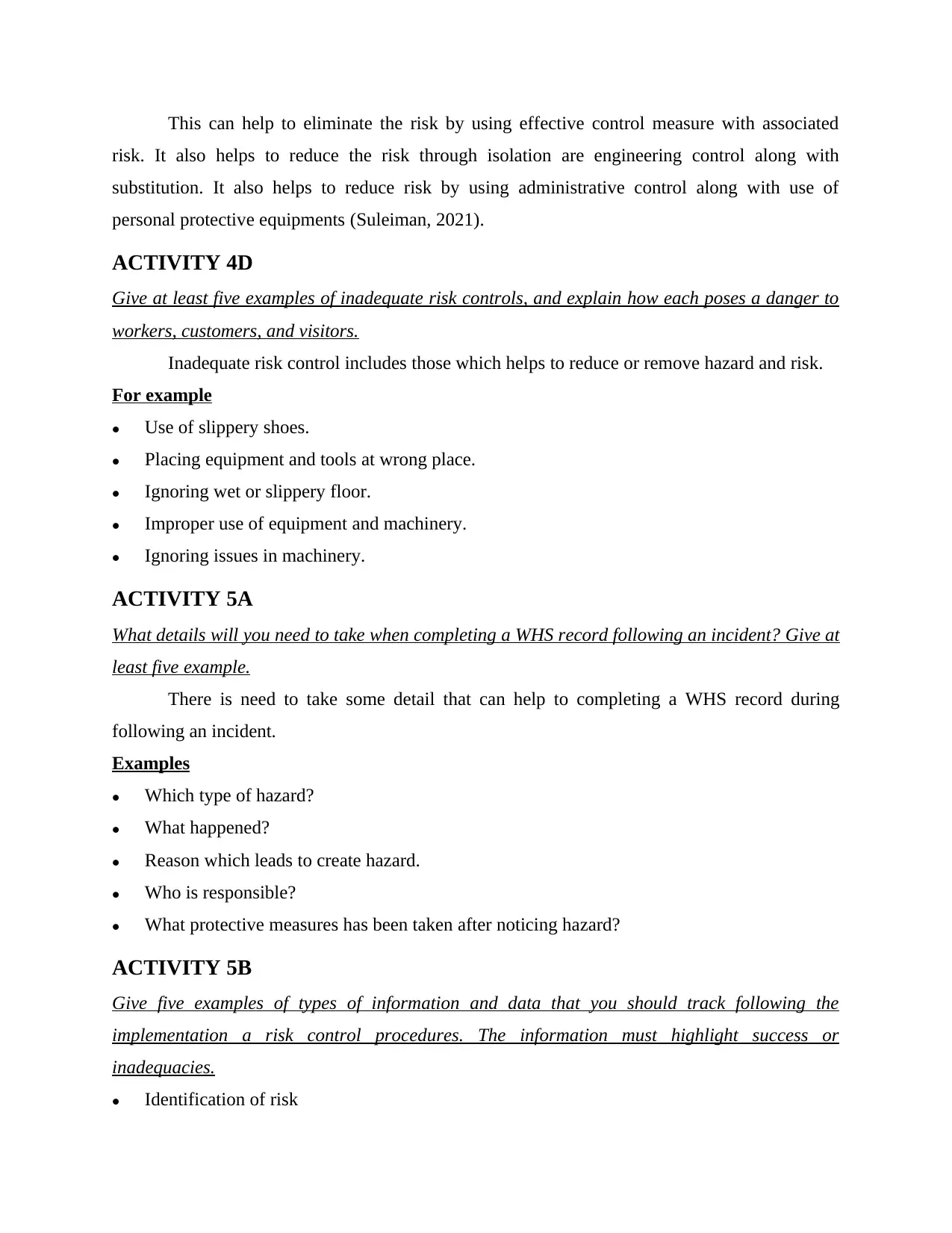
This can help to eliminate the risk by using effective control measure with associated
risk. It also helps to reduce the risk through isolation are engineering control along with
substitution. It also helps to reduce risk by using administrative control along with use of
personal protective equipments (Suleiman, 2021).
ACTIVITY 4D
Give at least five examples of inadequate risk controls, and explain how each poses a danger to
workers, customers, and visitors.
Inadequate risk control includes those which helps to reduce or remove hazard and risk.
For example
Use of slippery shoes.
Placing equipment and tools at wrong place.
Ignoring wet or slippery floor.
Improper use of equipment and machinery.
Ignoring issues in machinery.
ACTIVITY 5A
What details will you need to take when completing a WHS record following an incident? Give at
least five example.
There is need to take some detail that can help to completing a WHS record during
following an incident.
Examples
Which type of hazard?
What happened?
Reason which leads to create hazard.
Who is responsible?
What protective measures has been taken after noticing hazard?
ACTIVITY 5B
Give five examples of types of information and data that you should track following the
implementation a risk control procedures. The information must highlight success or
inadequacies.
Identification of risk
risk. It also helps to reduce the risk through isolation are engineering control along with
substitution. It also helps to reduce risk by using administrative control along with use of
personal protective equipments (Suleiman, 2021).
ACTIVITY 4D
Give at least five examples of inadequate risk controls, and explain how each poses a danger to
workers, customers, and visitors.
Inadequate risk control includes those which helps to reduce or remove hazard and risk.
For example
Use of slippery shoes.
Placing equipment and tools at wrong place.
Ignoring wet or slippery floor.
Improper use of equipment and machinery.
Ignoring issues in machinery.
ACTIVITY 5A
What details will you need to take when completing a WHS record following an incident? Give at
least five example.
There is need to take some detail that can help to completing a WHS record during
following an incident.
Examples
Which type of hazard?
What happened?
Reason which leads to create hazard.
Who is responsible?
What protective measures has been taken after noticing hazard?
ACTIVITY 5B
Give five examples of types of information and data that you should track following the
implementation a risk control procedures. The information must highlight success or
inadequacies.
Identification of risk
⊘ This is a preview!⊘
Do you want full access?
Subscribe today to unlock all pages.

Trusted by 1+ million students worldwide
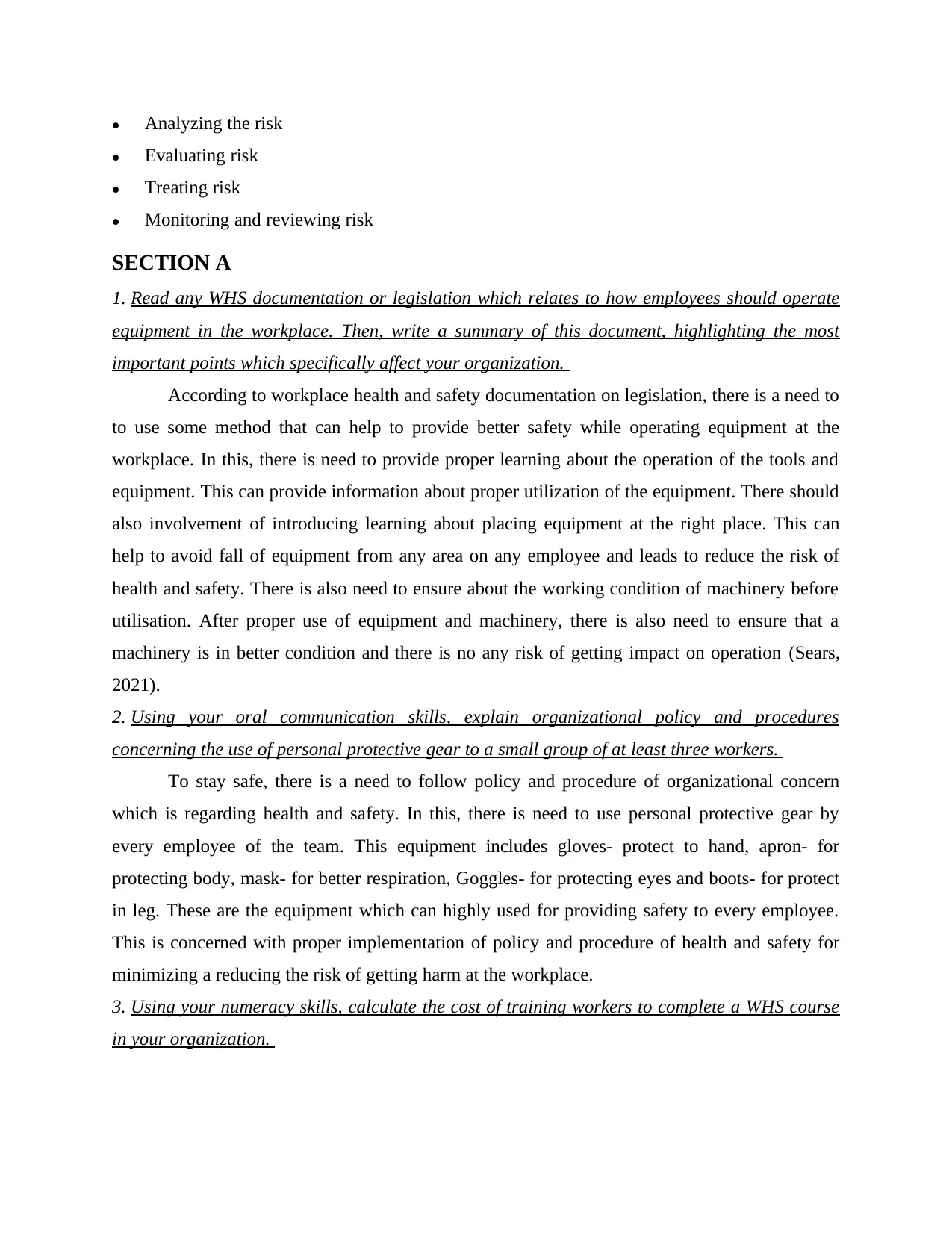
Analyzing the risk
Evaluating risk
Treating risk
Monitoring and reviewing risk
SECTION A
1. Read any WHS documentation or legislation which relates to how employees should operate
equipment in the workplace. Then, write a summary of this document, highlighting the most
important points which specifically affect your organization.
According to workplace health and safety documentation on legislation, there is a need to
to use some method that can help to provide better safety while operating equipment at the
workplace. In this, there is need to provide proper learning about the operation of the tools and
equipment. This can provide information about proper utilization of the equipment. There should
also involvement of introducing learning about placing equipment at the right place. This can
help to avoid fall of equipment from any area on any employee and leads to reduce the risk of
health and safety. There is also need to ensure about the working condition of machinery before
utilisation. After proper use of equipment and machinery, there is also need to ensure that a
machinery is in better condition and there is no any risk of getting impact on operation (Sears,
2021).
2. Using your oral communication skills, explain organizational policy and procedures
concerning the use of personal protective gear to a small group of at least three workers.
To stay safe, there is a need to follow policy and procedure of organizational concern
which is regarding health and safety. In this, there is need to use personal protective gear by
every employee of the team. This equipment includes gloves- protect to hand, apron- for
protecting body, mask- for better respiration, Goggles- for protecting eyes and boots- for protect
in leg. These are the equipment which can highly used for providing safety to every employee.
This is concerned with proper implementation of policy and procedure of health and safety for
minimizing a reducing the risk of getting harm at the workplace.
3. Using your numeracy skills, calculate the cost of training workers to complete a WHS course
in your organization.
Evaluating risk
Treating risk
Monitoring and reviewing risk
SECTION A
1. Read any WHS documentation or legislation which relates to how employees should operate
equipment in the workplace. Then, write a summary of this document, highlighting the most
important points which specifically affect your organization.
According to workplace health and safety documentation on legislation, there is a need to
to use some method that can help to provide better safety while operating equipment at the
workplace. In this, there is need to provide proper learning about the operation of the tools and
equipment. This can provide information about proper utilization of the equipment. There should
also involvement of introducing learning about placing equipment at the right place. This can
help to avoid fall of equipment from any area on any employee and leads to reduce the risk of
health and safety. There is also need to ensure about the working condition of machinery before
utilisation. After proper use of equipment and machinery, there is also need to ensure that a
machinery is in better condition and there is no any risk of getting impact on operation (Sears,
2021).
2. Using your oral communication skills, explain organizational policy and procedures
concerning the use of personal protective gear to a small group of at least three workers.
To stay safe, there is a need to follow policy and procedure of organizational concern
which is regarding health and safety. In this, there is need to use personal protective gear by
every employee of the team. This equipment includes gloves- protect to hand, apron- for
protecting body, mask- for better respiration, Goggles- for protecting eyes and boots- for protect
in leg. These are the equipment which can highly used for providing safety to every employee.
This is concerned with proper implementation of policy and procedure of health and safety for
minimizing a reducing the risk of getting harm at the workplace.
3. Using your numeracy skills, calculate the cost of training workers to complete a WHS course
in your organization.
Paraphrase This Document
Need a fresh take? Get an instant paraphrase of this document with our AI Paraphraser
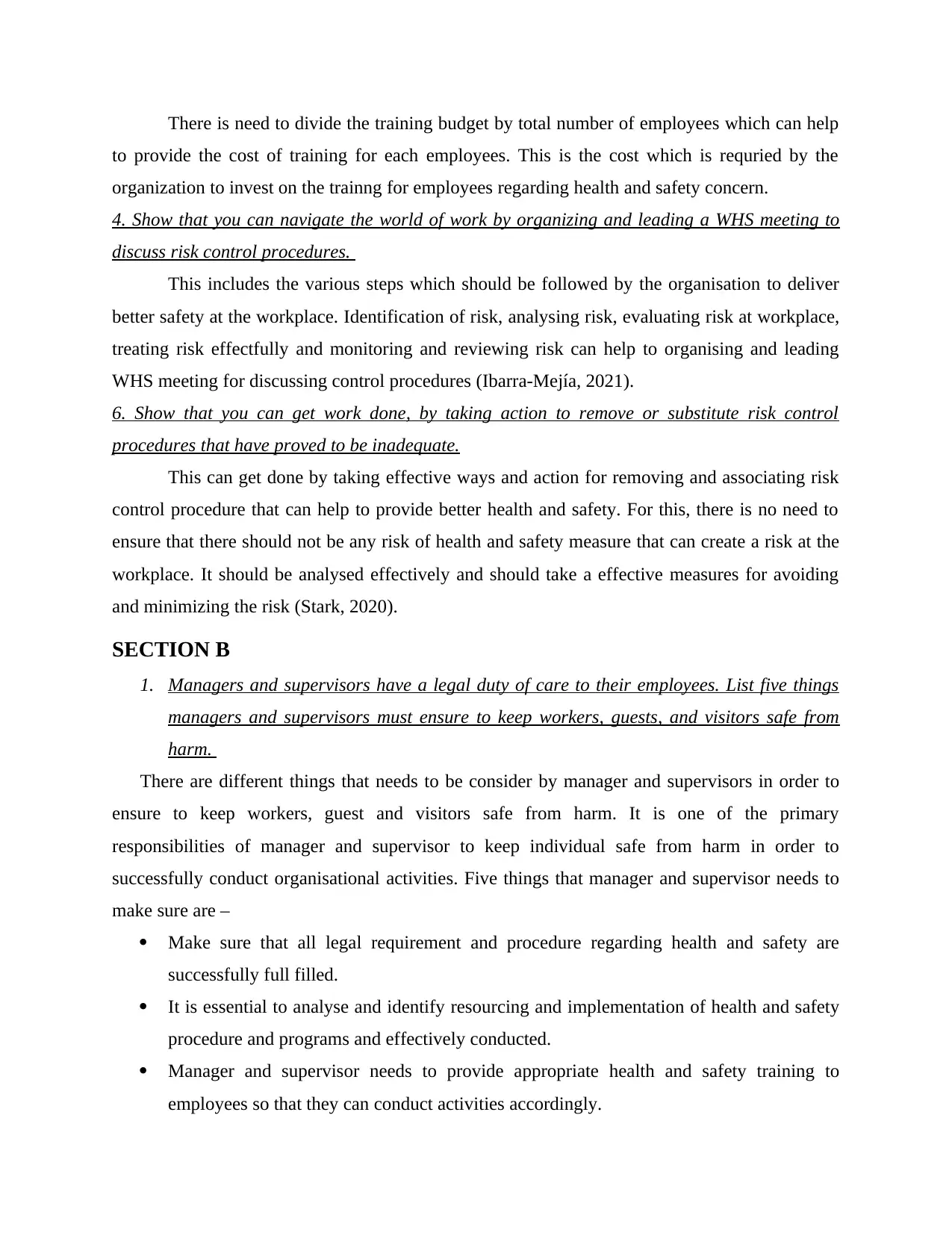
There is need to divide the training budget by total number of employees which can help
to provide the cost of training for each employees. This is the cost which is requried by the
organization to invest on the trainng for employees regarding health and safety concern.
4. Show that you can navigate the world of work by organizing and leading a WHS meeting to
discuss risk control procedures.
This includes the various steps which should be followed by the organisation to deliver
better safety at the workplace. Identification of risk, analysing risk, evaluating risk at workplace,
treating risk effectfully and monitoring and reviewing risk can help to organising and leading
WHS meeting for discussing control procedures (Ibarra-Mejía, 2021).
6. Show that you can get work done, by taking action to remove or substitute risk control
procedures that have proved to be inadequate.
This can get done by taking effective ways and action for removing and associating risk
control procedure that can help to provide better health and safety. For this, there is no need to
ensure that there should not be any risk of health and safety measure that can create a risk at the
workplace. It should be analysed effectively and should take a effective measures for avoiding
and minimizing the risk (Stark, 2020).
SECTION B
1. Managers and supervisors have a legal duty of care to their employees. List five things
managers and supervisors must ensure to keep workers, guests, and visitors safe from
harm.
There are different things that needs to be consider by manager and supervisors in order to
ensure to keep workers, guest and visitors safe from harm. It is one of the primary
responsibilities of manager and supervisor to keep individual safe from harm in order to
successfully conduct organisational activities. Five things that manager and supervisor needs to
make sure are –
Make sure that all legal requirement and procedure regarding health and safety are
successfully full filled.
It is essential to analyse and identify resourcing and implementation of health and safety
procedure and programs and effectively conducted.
Manager and supervisor needs to provide appropriate health and safety training to
employees so that they can conduct activities accordingly.
to provide the cost of training for each employees. This is the cost which is requried by the
organization to invest on the trainng for employees regarding health and safety concern.
4. Show that you can navigate the world of work by organizing and leading a WHS meeting to
discuss risk control procedures.
This includes the various steps which should be followed by the organisation to deliver
better safety at the workplace. Identification of risk, analysing risk, evaluating risk at workplace,
treating risk effectfully and monitoring and reviewing risk can help to organising and leading
WHS meeting for discussing control procedures (Ibarra-Mejía, 2021).
6. Show that you can get work done, by taking action to remove or substitute risk control
procedures that have proved to be inadequate.
This can get done by taking effective ways and action for removing and associating risk
control procedure that can help to provide better health and safety. For this, there is no need to
ensure that there should not be any risk of health and safety measure that can create a risk at the
workplace. It should be analysed effectively and should take a effective measures for avoiding
and minimizing the risk (Stark, 2020).
SECTION B
1. Managers and supervisors have a legal duty of care to their employees. List five things
managers and supervisors must ensure to keep workers, guests, and visitors safe from
harm.
There are different things that needs to be consider by manager and supervisors in order to
ensure to keep workers, guest and visitors safe from harm. It is one of the primary
responsibilities of manager and supervisor to keep individual safe from harm in order to
successfully conduct organisational activities. Five things that manager and supervisor needs to
make sure are –
Make sure that all legal requirement and procedure regarding health and safety are
successfully full filled.
It is essential to analyse and identify resourcing and implementation of health and safety
procedure and programs and effectively conducted.
Manager and supervisor needs to provide appropriate health and safety training to
employees so that they can conduct activities accordingly.
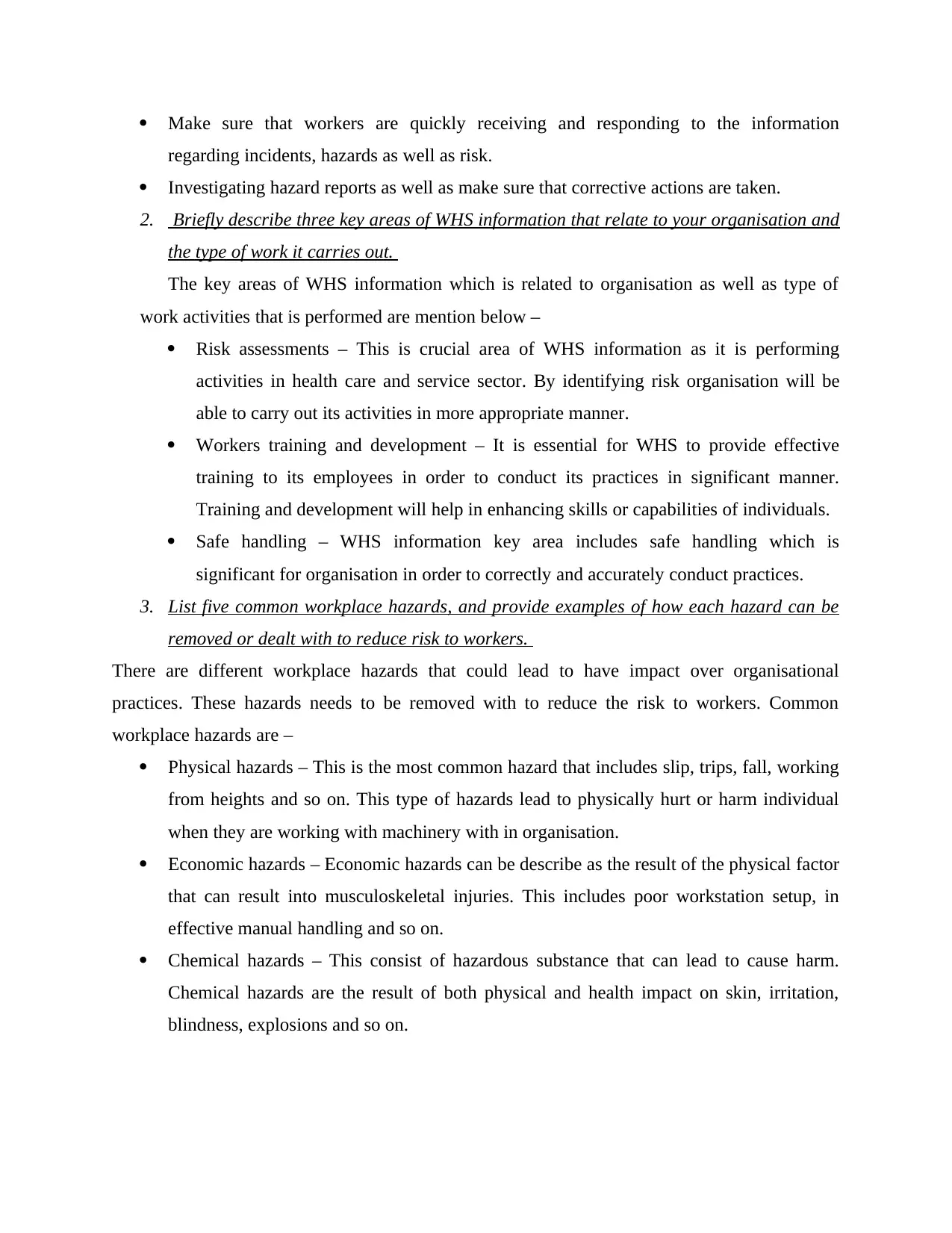
Make sure that workers are quickly receiving and responding to the information
regarding incidents, hazards as well as risk.
Investigating hazard reports as well as make sure that corrective actions are taken.
2. Briefly describe three key areas of WHS information that relate to your organisation and
the type of work it carries out.
The key areas of WHS information which is related to organisation as well as type of
work activities that is performed are mention below –
Risk assessments – This is crucial area of WHS information as it is performing
activities in health care and service sector. By identifying risk organisation will be
able to carry out its activities in more appropriate manner.
Workers training and development – It is essential for WHS to provide effective
training to its employees in order to conduct its practices in significant manner.
Training and development will help in enhancing skills or capabilities of individuals.
Safe handling – WHS information key area includes safe handling which is
significant for organisation in order to correctly and accurately conduct practices.
3. List five common workplace hazards, and provide examples of how each hazard can be
removed or dealt with to reduce risk to workers.
There are different workplace hazards that could lead to have impact over organisational
practices. These hazards needs to be removed with to reduce the risk to workers. Common
workplace hazards are –
Physical hazards – This is the most common hazard that includes slip, trips, fall, working
from heights and so on. This type of hazards lead to physically hurt or harm individual
when they are working with machinery with in organisation.
Economic hazards – Economic hazards can be describe as the result of the physical factor
that can result into musculoskeletal injuries. This includes poor workstation setup, in
effective manual handling and so on.
Chemical hazards – This consist of hazardous substance that can lead to cause harm.
Chemical hazards are the result of both physical and health impact on skin, irritation,
blindness, explosions and so on.
regarding incidents, hazards as well as risk.
Investigating hazard reports as well as make sure that corrective actions are taken.
2. Briefly describe three key areas of WHS information that relate to your organisation and
the type of work it carries out.
The key areas of WHS information which is related to organisation as well as type of
work activities that is performed are mention below –
Risk assessments – This is crucial area of WHS information as it is performing
activities in health care and service sector. By identifying risk organisation will be
able to carry out its activities in more appropriate manner.
Workers training and development – It is essential for WHS to provide effective
training to its employees in order to conduct its practices in significant manner.
Training and development will help in enhancing skills or capabilities of individuals.
Safe handling – WHS information key area includes safe handling which is
significant for organisation in order to correctly and accurately conduct practices.
3. List five common workplace hazards, and provide examples of how each hazard can be
removed or dealt with to reduce risk to workers.
There are different workplace hazards that could lead to have impact over organisational
practices. These hazards needs to be removed with to reduce the risk to workers. Common
workplace hazards are –
Physical hazards – This is the most common hazard that includes slip, trips, fall, working
from heights and so on. This type of hazards lead to physically hurt or harm individual
when they are working with machinery with in organisation.
Economic hazards – Economic hazards can be describe as the result of the physical factor
that can result into musculoskeletal injuries. This includes poor workstation setup, in
effective manual handling and so on.
Chemical hazards – This consist of hazardous substance that can lead to cause harm.
Chemical hazards are the result of both physical and health impact on skin, irritation,
blindness, explosions and so on.
⊘ This is a preview!⊘
Do you want full access?
Subscribe today to unlock all pages.

Trusted by 1+ million students worldwide
1 out of 16
Related Documents
Your All-in-One AI-Powered Toolkit for Academic Success.
+13062052269
info@desklib.com
Available 24*7 on WhatsApp / Email
![[object Object]](/_next/static/media/star-bottom.7253800d.svg)
Unlock your academic potential
Copyright © 2020–2025 A2Z Services. All Rights Reserved. Developed and managed by ZUCOL.





